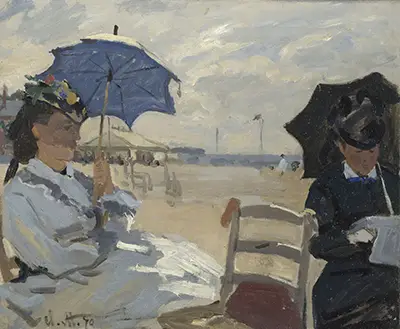In a rare testament to its authenticity, the canvas of La Plage de Trouville contains grains of sand blown onto the artist's easel by the fresh sea breeze. Monet's brush strokes are bold and strong, creating a striking contrast to the muted colours and blurred features of the two figures in the painting. A prime example of the en-plein-air technique of painting, this Impressionist masterpiece highlights the themes inherent in Impressionism and present in most of Monet's works. The painting perfectly captures a moment by the seaside, with the sky obscured by overhanging clouds.
La Plage de Trouville was created during Monet's honeymoon in 1870. On the left of the picture, seemingly lost in thought, is Camille Doncieux, the painter's wife. Next to her, holding a dark parasol and shrouded in dark clothes, is the wife of Monet's mentor, the famed Impressionist painter Eugene Boudin. In keeping with Impressionism's idea of capturing a moment - an 'impression' -in time, La Plage de Trouville encapsulates the fleeting and ever-changing landscape of a windswept beach. The figures, despite featuring prominently in the foreground, aren't given much attention. Both Camille and Madame Boudin lack any discernible features, their faces obscured by the shadows cast by their parasols.
Camille's clothing is white and breezy, her hat adorned with flowers. Madame Boudin, on the other hand, cuts a rather stern figure in her all-black ensemble and matching dark parasol. The Normandy coast is commonly regarded as the birthplace of Impressionism. Drawing from its unique natural light and its breathtaking landscapes, painters like Claude Monet, Auguste Renoir and Eugene Boudin created a new style that sought to abandon traditional painting techniques. Impressionism, as this new movement came to be known, tasked itself with involving the viewer into the play of light and shadow, thereby eliciting an emotional response.
Eugene Boudin, the father of Impressionism and Monet's mentor, proved momentous in advancing Monet's career and painting style. It was Boudin who taught his younger protege about the interaction of light and dark, and it was also from him that Monet learned to focus on the sky, making it the focal point of his paintings. Nowhere is this better evidenced than in his famous painting Impression, Sunrise depicting the sun rising over the port of Le Havre, Monet's hometown. La Plage de Trouville reveals the essence of Impressionism: the jerky brush strokes, the blurred lines and the play of light and colour all add to the feeling of yearning and immediacy.
While other art movements have been intellectual, pompous even, obsessed with the painstaking rendition of the minutest details, Impressionism is intuitive. Rather than create an exact depiction of a landscape, person or object, painters like Claude Monet and his cohorts preferred to experiment with light, colour and texture. Over the course of his life, Monet perfected his technique that would go on to be regarded as the essence of Impressionist aesthetics. Monet devoted himself to painting landscapes en plein air, using the natural play of light and shadow to his advantage.


